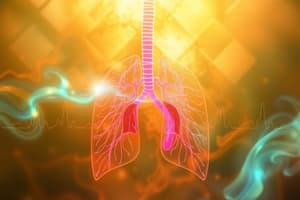Podcast
Questions and Answers
Why is it important for nurses to learn how to interpret Arterial Blood Gases (ABGs)?
Why is it important for nurses to learn how to interpret Arterial Blood Gases (ABGs)?
It is important for nurses to interpret ABGs to report to the doctor and properly oxygenate their patients based on the results.
Which of the following are examples of abnormal ABG results? (Select all that apply)
Which of the following are examples of abnormal ABG results? (Select all that apply)
- Normal pH
- Metabolic Alkalosis (correct)
- Respiratory Acidosis (correct)
- Metabolic Acidosis (correct)
What is the normal range for pH in ABG results?
What is the normal range for pH in ABG results?
7.35-7.45
What is the normal range for CO2 in ABG results?
What is the normal range for CO2 in ABG results?
What is the normal range for HCO3 in ABG results?
What is the normal range for HCO3 in ABG results?
The CO2 lab value always indicates a respiratory issue.
The CO2 lab value always indicates a respiratory issue.
The HCO3 lab value always indicates a metabolic issue.
The HCO3 lab value always indicates a metabolic issue.
Using the tic tac toe method, what does a pH of 7.24 indicate?
Using the tic tac toe method, what does a pH of 7.24 indicate?
Using the tic tac toe method, what is the conclusion if pH is acidic and PCO2 is also acidotic?
Using the tic tac toe method, what is the conclusion if pH is acidic and PCO2 is also acidotic?
What type of metabolic issue is indicated by a pH of 7.50, PCO2 36, and HCO3 32?
What type of metabolic issue is indicated by a pH of 7.50, PCO2 36, and HCO3 32?
In the example of pH 7.37, PaCO2 33, and HCO3 17, what type of compensation is present?
In the example of pH 7.37, PaCO2 33, and HCO3 17, what type of compensation is present?
Flashcards are hidden until you start studying
Study Notes
Importance of ABG Interpretation
- Nurses must interpret Arterial Blood Gases (ABGs) to ensure proper patient care.
- Many new nurses feel uncomfortable with ABG analysis and may overlook its importance, assuming it's solely the respiratory therapist’s task.
- Understanding ABGs allows nurses to relay critical information to doctors and to appropriately manage patient oxygenation based on ABG results.
Types of Abnormal ABG Results
- Abnormal results can indicate various conditions:
- Respiratory Acidosis (can be uncompensated, partially compensated, or fully compensated)
- Respiratory Alkalosis (can also be uncompensated, partially compensated, or fully compensated)
- Metabolic Acidosis (same types of compensation)
- Metabolic Alkalosis (same types of compensation)
Normal ABG Ranges
- Normal pH: 7.35 - 7.45
- Normal CO2: 35 - 45 mmHg
- Normal HCO3: 22 - 26 mEq/L
Interpretation of Lab Values
- CO2 levels indicate respiratory issues.
- HCO3 levels indicate metabolic issues.
Tic Tac Toe Method for ABG Analysis
- A structured approach for analyzing ABG results to determine the underlying condition.
- Steps include determining the position of pH, PCO2, and HCO3 under their respective columns (acid, normal, base).
Example Problem Using Tic Tac Toe
- Given values: pH 7.24 (acidic), PCO2 75 (acidic), HCO3 28 (basic)
- Results indicate respiratory acidosis with partial compensation by the metabolic system.
Practice Problem Analysis
- Given values: pH 7.50 (basic), PCO2 36 (normal), HCO3 32 (basic)
- Results indicate uncompensated metabolic alkalosis.
Another Practice Problem
- Given values: pH 7.37 (normal but acidic), PaCO2 33 (alkalotic), HCO3 17 (acidic)
- Represents full compensation; the metabolic issue is the underlying problem despite pH being normal.
Studying That Suits You
Use AI to generate personalized quizzes and flashcards to suit your learning preferences.





